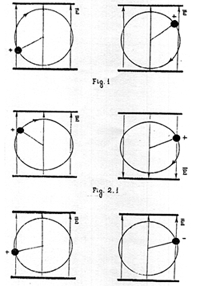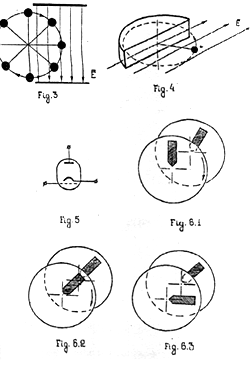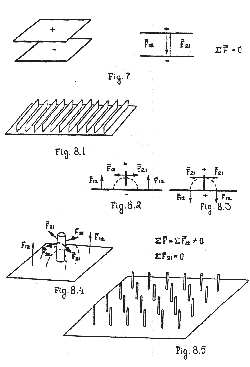
Fig. 1, Fig.2.1, Fig.2.2.
Alexander V. Frolov
This paper was published in Newsletter of Planetary Associationfor Clean Energy, Vol.8(1), Sept.1994. It is the same paper which was publishedat first in New Energy News, May 1994, but this version was edited by Dr.Thomas E. Bearden, Association of Distinguished American Scientists. Hisaddress: POB 1472, Huntsville, Alabama 35807, fax (205)536-0411
Professional physicists dislike considering the use of potentials forthe creation of work in the load. This is explainable in view of theirstaunch footings in the Law of Conservation of Energy.
Yet it is possible to demonstrate there is in fact no rule in Natureagainst free energetics. The simple availability of potential fields isa sufficient condition for the driving of fuel-less power systems. Oncesuch a system is operational, certain effects emerge which are connectedto the Law of Conservation of Energy and which suggest the formulationof this Law in a more general view.
The solution of the reactionless support-free motion problem is providedby means of asymmetrical potential interaction is also proposed.
There is an "indisputable" formulations that is universally appliedby physicists: the total work of the Potential field along a closed trajectoryis equal to zero. Indeed, from Fig.1 we can see that part of thework is positive (acceleration) and the other part ot the work is negative(deceleration).
Fig. 1, Fig.2.1, Fig.2.2.
In Physics textbooks, the task of applying the Potential for makingonly positive work in both parts is absent. This may be explained by theunwillingness of textbooks writers to discuss the more interesting questionof energy transformations when the inner structure of space-time is changed.Figure2 shows the same charged mass M rotation in an potential electricfield. The difference is in the mode of interaction. The polarity of itis changed when positive work is changed to negative. Figure 2.1 showsthat the direction of field is changed. Figure 22. shows that the signof the charge is changed.
There is a another set of simple examples of application of potentialfield for the creation of only positive work in the load. Figure 3 is anarrangement similar of a water mill wheel.
Fig.3, Fig.4, Fig.5, Fig.6
Now let's compare this to Figure 1. Can you see the miller who submergedthe entire wheel in the river water flow and thereby 'scientifically' provedthat it is impossible to use water flow for the creation of power ? Butour professors use a similar argument to show that the total work of thepotential in a closed cycle is always zero!
Actually, the part of the trajectory, or periodic cycle which constitutesnegative work (deceleration) portion may be excluded by means of spatialsuperimposition, pulsed mode, change of interaction polarity, or by meansof a screen (Fig. 4.)
Fig. 5 shows that changes in the arrangement of electrodes ot vacuumtubes allow one to increased the energy of emission current electrons.
These basic schemes concepts require further development for industrialapplication, of course. Note that Coulomb's interaction is inversely proportionalto the square of the distance, so it is necessary to try to decrease thisdistance to obtain greater interaction. Figure 6 shows a "free energy"device similar to a well-known electric machine. Let us consider the interactionof 2 segments that have opposite charges. In the case of a constant signof interaction, the process corresponds to the above "totally submerged"water wheel conclusion of the miller. Figure 6. 1 shows that the attractionbetween segments creates a propulsion force and that the rotor is movingwith some acceleration. Figure 6.2 notes the point of balance, and thenFigure 6.3 shows that the rotor is decelerated since segments remain inattraction. The total work of the potential field is equal to zero. Butwhy? It is not an indispensable condition of Nature. It enough to changethe sign of interaction between
segments, after the balance point, from attraction to repulsion tocreate the mode of acceleration again! And this can be done by judiciouslyswitching (reversing) the potential itself at the appropriate time. Inthis case both halves of the cycle are in acceleration. We omit the technologicaland descriptions of the group of contacts, collector brushes, condensers,transformers, and so on.
It is not news that potential fields can perform work Any textbook showexamples of closed circuit negative-positive cycling of suchwork and proves that the total work of successive acceleration and decelerationis equal to zero. But since this closed circuit process is actually thesuccessive performance of two work processes, it is possible to changethe parameters of one process and change the cycle into the sum of twoor several sequential parts, each of positive work The trick is in thepoint-momentum of balance.
Let us consider the use of potential field for the creation of propulsionforce and reactionless, support-free motion. Figure 7 shows an ordinaryflat electric condenser.
Two flat plates are in attraction (different charges) or in repulsion(like charges). The total resultant force of the two-plate system equalsto zero and the material system of the charged condenser remains immobile.To discover a solution for a non-zero unilateral resultant force, all weneed is to note that the force line of the potential field is always perpendicularto the charged surface and take advantage of that fact.
Figure 8 shows the same condenser but one plate is perpendicular withregards to the other plate. The vertical plate is divided into severalelements in order to decrease distance of Coulomb's interaction betweenplates. The total force resultant between any two vertical elements isthe sum of opposing forces and it equals to zero. But the total force thatapplies between a vertical plate and the horizontal plate is a sum of co-directionalelementary forces and it is not equal to zero. The system
thus moves by means of its asymmetrical potential interaction.
Note that the perpendicular elements may have cylindrical shape. Thepropulsion force may be regulated by means of change of angle between platesof the asymmetrical condenser or by of a changing the potential.
The well-known experiments with "inertioidal" moving systems may beconsidered as a particular case of asymmetrical (vector) potential technology.When eccentric mass is moving along epicycloidal or cardioidal trajectory,it creates a propulsion force that is the result of the gradient of acceleration. This process is described by a vector potential conception. Since asymmetricalscalar potential interaction does not require additional power after isgeneration, the scalar technology is more interesting for the aerospaceindustry than inertial propulsion systems.
(With T.E.Bearden's commentary)
We pose a common sense question: Where do we take the power from, formaking work in the load, if we use potential energy for it and the potentialis not exhausted? Note that the existence of force effects of potentialfields must raise the same question.
Why magnets don't exhaust?
Why can a simple permanent magnet (with its vector potential) hold andsuspend a massive piece of metal when in so doing it continually makeswork against force af gravity and yet it does not require any fuel andpower And the magnet does not weaken and is not exhausted?
E. T. Whittaker's conception of potential as a bi-directional flow ofenergy is developed by T.E. Bearden in Gravitobiology. The generalizationof Newton's Third Law in this conception leads to a requirement of complementarypairs of conjugate photons for the electromagnetic radiation process. Sincethe process means the change of information (i.e., of the structure ofspace) in time, the pair's anti-process takes place in reverse-time. Certainly,the anti-process is developed from its
own past time in the future, but from our point of view it is changesfrom the future in past time. In this generalized Newton's Third Law theinner structure of the electric potential field is created by two oncomingflows of energy: the photons are spreading from the charge-source of thepotential field and the antiphotons are inflowing into that point-centreof charged mass.
Now let's return to a question that rings true: Since "something" cannotspring up from "nothing", what is "reduced' or depleted, and where, ifin the local area of our space-time the free energy process takes placeand some power is dispersed in the load?
T. D. Lee's "vacuum engineering"
Let's generalize this question. 'Space-time" and "potential" and "energy"are identically the same thing. In this conception, the well-known abilityof energy to change its form is extended to allow energy to "change" intoa space-time change, and vice-versa. This notion is already inherent ingeneral relativity. In this manner we invert the usual notion that energymoves through an inert, featureless space-time (vacuum) to interact upona mass and alter its energy, position, mass, charge.
or all four. Instead, we now have extended and applied John ArchlbaldWheeler's admonition that "Space acts on matter, telling it how to move"[1]. Bearden calls such action upon a mass by the local space-timeand its dynamic structure a vacuum engine, after the "vacuum engineering"suggested by Nobelian T. D. Lee. [2]
Thus from "energy" as "ordering and disordering" of the hidden spatialstructure, we arrive at energy as a descriptive of any process. The noteof "process" as the change of information or spatial structure in timefrom the point of view of the observer explains the effects that are connectedwith changes of natural potential field energetics balance.
Potentials are bi-directional
So the potential field can be considered as a bi-directional process/anti-process.Usually energyinformation that is radiated by the source of the potentialfield (the direct process in time) has some difference with the energyinformationthat is received (the anti-process in reverse-time). This difference causesthe rate of time for this mass object and causes the existence of thismass as the source of the potential field. This difference is equal totrapped energy of mass-form that can be transformed into radiation energy,as the cause of mass decay. If the potential field is used only for makingpositive work of acceleration, then according to the Conservation Law thepower process in space-time must be balanced by a corresponding power anti-processin the space of reverse-time. This imbalance of bi-directional flow ofpotential energy shows itself as a local change of spatial
curvature and a change in the local rate of flow of time.
High energetic vacuum
The concept of the highly energetic Vacuum is fully accepted in physics.It has been thermodynamically shown that in principle the electrical energyof the vacuum can be extracted as heat and power [3]. It only remains tomake the local vacuum potential partially asymmetrical, then gate and freelyutilize the energy available from that asymmetry.
If it is necessary for technology, it is possible to make calculationsof the amount of power that must be dispersed as heat to obtain the modeof total compensation of natural spatial planet curvature and rate of timein the local area of space-time.
The comprehensive conservation
So it is impossible to create "something" from "nothing". But the creationof an external "free energy" flow process is balanced by a correspondinginternal anti-process and you do not create "something from nothing" from the point of view of Eternity. Consequentlysuch a process does not violate the laws of physics.
Further, mass itself consists of trapped energy, so it may be consideredto be a very strong, localized scalar potential [4]. This potential alsomust consist of bi-directional wave pairs, and thus be subject to directelectromagnetic engineering by means of external alteration of its constituentWhittaker waves.
The unreality of matter
So after Whittaker's representation of conventional electromagneticsas a function of two scalar potentials and his decomposition of any potentialinto bi-directional wave pairs, it becomes possible experimentally verifythe old philosophical idea of the unreality of material existence. Thedeparture from the static notion of mass to a dynamic description of thematerial world's existence allows the development ot the conception ofthe electromagnetic design template of local physical reality. Since themass (and matter) is a process that is balanced by a reverse-process, thereare no difficulties in principle to develop such technologies as transmutationof chemical elements [6], materialization and dematerialization, teleportationand so on.
No violation at Law of Conservation
The application of potential energy for the creation of power does notviolate the Law of Conservation of Energy that remains true in the moregeneral global view:
The complete energy of a four-dimensional system is the sum ofits energy of space-time processes and its energy of space-reverse-timeprocesses, and it is constant and equal to zero.
1. W. Misner, K.S. Thorne and J.A.Wheeler, Gravitation, W.H. Freemanand Co., San Francisco, 1973, p.5.
2. Lee, T.D. Particle physics and introduction to fled theory.Harwood. New York, 1981. Ch. 25: Outlook: Possibility of vacuum engineering:p. 824-828.
3. Cole, Daniel C. and Harold E. Puthoff, Extracting energy andheat from the vacuum, Physical Review, Vol. 48, No. 2, Aug. 1993, p.1562-1585.
4. T.E. Bearden, A redefinition of the Energy Ansatz, leading to afundamentally new class of nuclear reactions. Proceedings of the 27th IntersocietyEnergy Conversion Engineering Conference (IECEC 92). Town & CountryHotel Convention Centre, San Diego, California, 1992, p. 4.303-4.310.